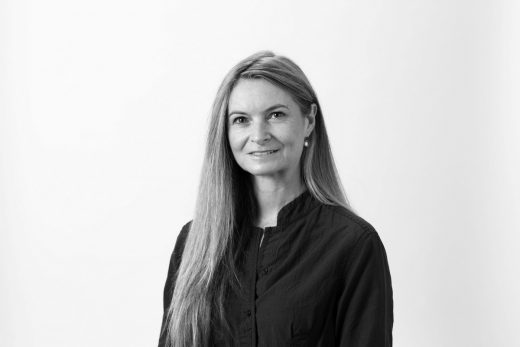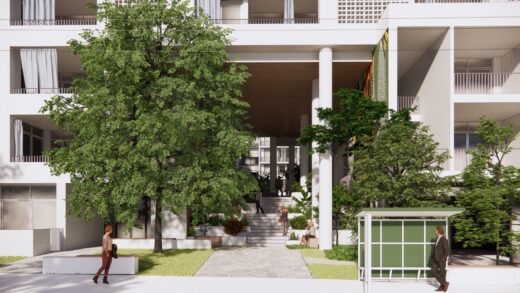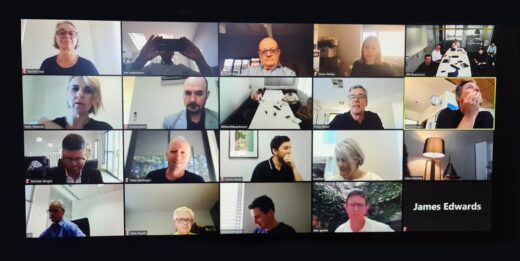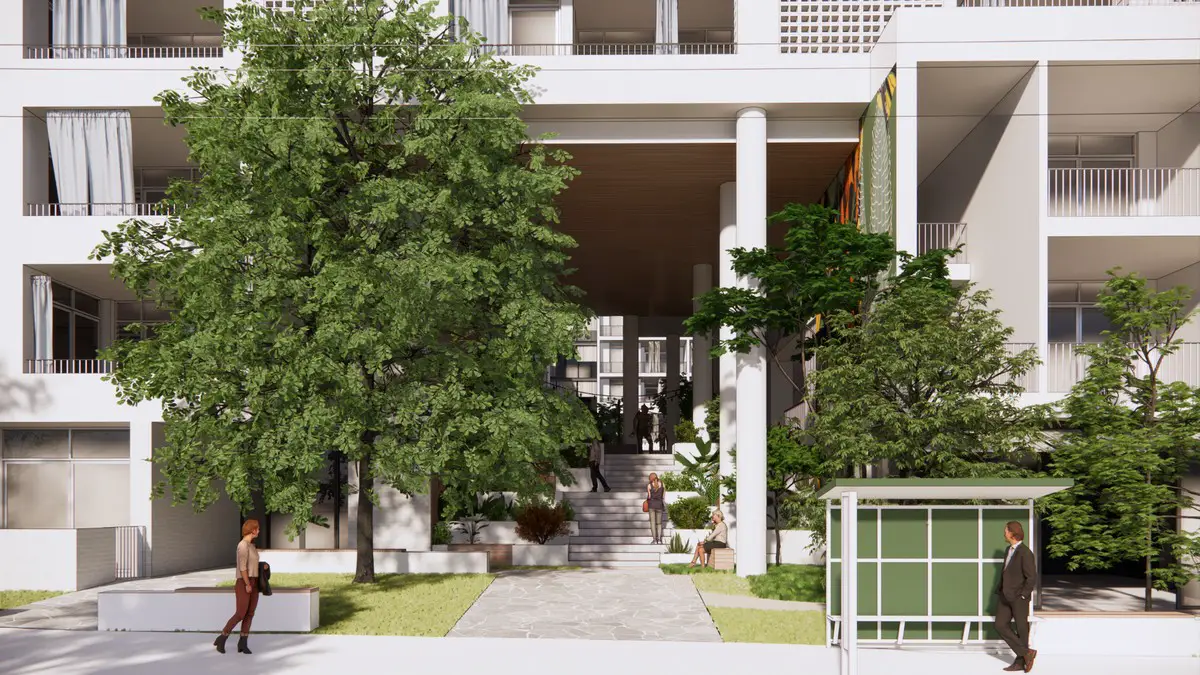Build to Rent Australia residential development, Leasing dwellings guide, Long-term tenancies
Australian Build to Rent: residential development
30 Apr 2021
Article by Shannon O’Shea – Hames Sharley Senior Associate, Australia
If You Build It, They Will Rent
It’s only a matter of time before Build to Rent makes its mark on Australian residential development. But what will that mean for the design process?
Already a significant success in the US and the UK, Build to Rent flips the idea of selling all the apartments in a residential development in favour of investors retaining ownership and leasing dwellings with long-term tenancies. Often situated close to public transport or employment hubs, these developments offer improved access to jobs, a high level of amenity, and increased emphasis on the importance of community within the development.
Hames Sharley Associate Director Shannon O’Shea:

photo courtesy of architects office
While government incentives for the idea have improved lately, the idea has yet to take hold on the Australian market, however, often held back by a host of factors such as GST implications, the high cost of land, and the perception that its return on investment takes too long. But while adoption itself has been sluggish, designers and planners are staying ahead of the trend by understanding how this new asset class will affect their work and deliver solutions to some current urban and societal challenges. Many, for example, believe the model heralds the solution to both Australia’s increase in renters by lifestyle choice and the well-publicised lack of affordable housing. It also promises a more solid investment opportunity in these unsettled times.
“COVID has heightened the fragility of some other asset classes such as retail and commercial investment,” says Tim Boekhoorn, Associate Director and Residential Portfolio Leader at Hames Sharley. “Build to Rent can be seen as a more stable investment because residents generally look for stability of tenure, where private investments are largely year-by-year prospects. Build to Rent operators look for retention of residents for stabilised income.
“It’s also an asset class that is supportive, filling a need in regard to affordability, connectivity and security through institutional investors. It can be a win-win scenario because it should drive better-quality developments and better-quality tenants who seek a balance between price, design, quality and community.”

picture courtesy of architects practice
With a focus on a longer-term future for the building, Build to Rent also promotes a designer-led outcome.
“Because it’s a longer-term investment and commitment – and so largely immune to the fickle changes in housing demand and property speculation – it needs to remain viable and attractive for far longer,” says Associate Director Shannon O’Shea, a highly experienced urban designer and master planner at Hames Sharley. “It is no longer about the strategy of ‘design and depart’. In these residential projects, the building footprint will have a lasting legacy for the place and its inhabitants.”
That positive legacy of longevity is a key difference between Build to Rent developments and the traditional Build to Sell. That’s not to say that homes being built for sale can be expected to fall to pieces in a short space of time – of course, they too are built to last. But in the case of Build to Rent, where the success or failure of the project is directly linked to ensuring constant, long-term occupation, the need to provide lifestyle, amenity, and community over many years for many residents, takes on a greater significance.
For designers working on such developments, that means a great deal of thought is needed as to who will end up living in the homes – more so than in traditional builds.
“Too often, housing design is for an assumed and generalised ‘market-norm’ buyer, ignoring the changing nature of Australian demographics and household formations,” says Shannon. “The idea of housing designed for a moment in time – as an investment or a consumer product – is not necessarily always fit for purpose or suited to current or changing needs of residents.”
Build to Rent also offers more opportunities for sustainable design that can sometimes be overlooked in residences built to sell. “Various initiatives may improve the quality and lifecycle costs of the building but they are often overlooked because their costs are passed on through increased asking prices,” Tim explains.
Given the need for the building to remain both attractive and viable over the long-term, designing for sustainability is a key concern, as is the need to minimise maintenance. For a recent Build to Rent project, the designers at Hames Sharley were tasked with ensuring that the interior design specifications were covered by stringent warranties. Even short-term upkeep can be reduced if addressed early in the process – in the same project, for example, the location and access to windows was well considered in order to reduce ongoing costs for window washing.
The Build to Rent concept, however, must be more than a reflection of a building’s functionality.
“It needs to create an emotional experience for the residents,” says Shannon “It’s about offering a lifestyle and long-term relationships between neighbours – similar to a street of homeowners that remain living together for many decades. Therefore, it is absolutely vital to design spaces that encourage interaction and shared experiences to create a cohesive, supportive community over time.”
Research into the nature of the target residents must therefore go beyond what is required for a Build to Sell project – when it’s vital tenants stay as long as possible, everything must be more carefully matched to their particular needs. That’s not merely a high level of amenity but amenity that plays to specific personalities, lifestyles, values and incomes. Designers must therefore do all they can to ensure the occupants not only mesh well with their homes but with each other.
“The base building must provide readily available spaces for residents with serendipitous opportunities to engage,” Shannon explains. “To form acquaintances and friendships and to foster co-existence between the many.”
Much thought is therefore required for the provision of shared connection. Sufficient area is needed for whatever will draw together the project’s ideal tenants, whether that be health and wellness spaces, crèches, co-work space or small allotments for growing your own vegetables.
For the community to thrive further, however, it must be allowed to grow and evolve in place, and that drives another major consideration for designers: how can you stop residents leaving, if their circumstances change? That can mean anything from singles seeking to share accommodation within a two-bedroom unit, to young couples seeking two to three bedrooms to grow their families, to empty-nesters seeking to downsize.
“Build to Rent enables residents to easily access housing opportunities that suit their stage of life – such as ageing in place – removing the expense and upheaval of moving while remaining part of their community,” Shannon says. “The design needs to provide the option for residents to move within the building, and upgrade as their circumstances change.
“This brings into focus the flexibility and adaptability of spaces, and the durability of materials to facilitate changing needs, suitable for all ages, abilities and life stages.”
Simple but crucial design considerations in these instances might include providing flat floors, wide doorways, and equitable bedroom sizes that enable people to stay in the same building as their lives progress. And again, it dovetails with the amenities provided outside the apartments themselves.
“People are more willing to live in a one-bedroom, not needing a second as a study, if the shared communal space can provide the same facilities,” says Shannon.
Overall, then, the designer’s role must be more interrogative on a Build to Rent project, purely because the target residents of the development will be so much more specific than Build to Sell, (where literally anyone could buy and move into a new building and the turnover of tenanted properties can be as frequent as every six months to a year).
“The process naturally fosters collaboration, allowing for the greater creativity, initiative and innovation to deliver the high standards of design a Build to Rent development expects,” says Shannon.
“The upfront research and analysis brings together a team of highly skilled individuals from diverse backgrounds. Planners, urban designers, architects, interior designers, investors, developers, professional managers and advisors, all contributing to the project when addressing the site location, connections, target market, user needs, spatial configuration and place experience.
“The designer needs to develop a good brief with the owner to understand who they are designing for, and what their requirements, aspirations and quality standards will be.”
This emphasis on collaboration and consultation, however, feeds into one of the main blockers for Build to Rent in Australia: that the initial costs (including those to facilitate the required market and design research) are too high for investors still struggling to overcome the idea that return on investment needs to be fast.
“It can be costly and take some time but it mitigates risk,” Shannon explains, “providing comfort for investors in the longer term, ensuring the development best meets the rapidly evolving needs of current and future generations, and enabling flexibility to adapt over time.
“Good design does not cost – when measured across the lifetime of the building, it saves money. It will increase the functionality while reducing ongoing operating costs, which account for a significant proportion of the whole-life costs.
“As designers, our role in the success of Built to Rent in Australia will draw on our experience with a focus on people at the heart of communities, creating spaces and places that inspire and strengthen connections while fostering their ongoing evolution.”
Shannon O’Shea – Hames Sharley Senior Associate
Shannon has played a central role leading multi-disciplinary teams dealing with complex urban environments. As a highly experienced Urban Designer and Master Planner, she brings a depth of experience working in both the public and private sectors across Australia and New Zealand.
Shannon is a highly effective communicator successfully bridging the gap between planning, architecture and stakeholder engagement for a wide range of projects.
Build to Rent: Australian residential development images / information received 130721
Previously on e-architect:
Architecture Design
Contemporary Building Designs – recent architectural selection from e-architect below:
COVID-19 Crisis Impact on Buildings
Construction Industry recovery news
Doing your homework on working remote – Hames Sharley employees in a Zoom meeting:

COVID-19 Remote Working
How COVID-19 changes urban design
COVID19 Impact on guest journey
How COVID-19 changes the way we work
Comments / photos for the Build to Rent: Australian residential development page welcome





